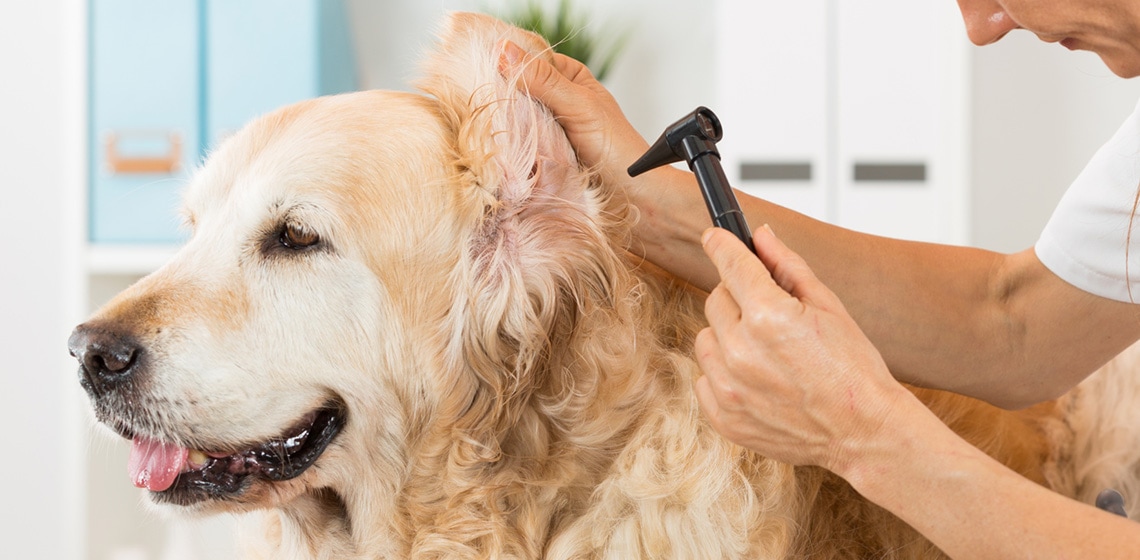Aural hematomas are relatively common in dogs. There are a number of different treatments to prevent scarring of the ear, but it’s important to also treat the underlying cause of the hematoma.
Severity:
Mild-moderate
Table of Contents
Key points
- It is not contagious or transmissible to dogs or other pets
- There’s always an underlying cause that should be identified
- Treatment should always be under the direction of a vet
Common in
All dogs, some breeds more than others
Symptoms & types
A ‘hematoma’ is a blood-filled lump that often occurs on the ears of dogs. The ear flap (pinna) fills with blood resulting in a swelling on the dog’s ear. This results in a dog who may hold their head and ear to one side in discomfort, shake their head, or scratch at the ear.
Unless the ear is drained, the hematoma will eventually scar over producing the classic ‘cauliflower ear’ seen in some sportsmen.
A ‘hematoma’ is a blood-filled lump that often occurs on the ears of dogs.
Understanding the diagnostics
Aural hematomas are usually diagnosed on sight – they’re very distinctive. Sticking in a needle and confirming that they’re filled with blood confirms the diagnosis.
However, diagnosing the underlying cause of the hematoma is more difficult. Hematomas are usually caused by a broken blood vessel in the ear. This blood vessel breaks usually because a dog is shaking their head, but it can also be broken when fighting with another dog. The hematoma will struggle to heal if the headshaking is continuing, so getting to the bottom of what’s causing the headshaking is important.
Your vet may look down your dog’s ear with an otoscope, take swabs for microscopy, or even recommend examination under sedation. In some cases, further imaging using CT may be helpful.
Hematomas are usually caused by a broken blood vessel in the ear.
Learning About The Causes
Hematomas in dog ears are almost always caused by headshaking. Finding out why your dog is shaking his head will help to treat the hematoma and prevent it from recurring.
The causes of head shaking in dogs include:
- Ear infection
- Allergies
- Ear mites
- Foreign object in the ears (such as a grass seed)
- Neurological conditions
- Ear tumors
For most of these causes, an examination with an otoscope will get your veterinarian a good way to determining the reason for your dog’s headshaking and subsequent hematoma. A swab, examined under a microscope or sent to a lab, can also be helpful. In some cases, further tests will be necessary, including advanced imaging using a CT or MRI machine.
Hematomas in dog ears are almost always caused by headshaking. Finding out why your dog is shaking his head will help to treat the hematoma.
Best Treatment Options
There are several methods for treating aural hematomas in dogs’ ears. All of them require a veterinarian. However, leaving the aural hematoma is also an option – as long as you treat the underlying disease.
The treatments for ear hematomas in dogs are broadly split into two categories – surgical and non-surgical. Non-surgical treatments usually involve draining the ear (which is often done conscious) and injection of steroid. This can be a cost-effective option, but it may be less likely to work. If the ear refills, the non-surgical option can be tried again, or you may wish to try the surgical option.
Surgical treatments involve cutting the ear open, draining the blood, then sewing the ear together so that it can’t re-fill. Sterilized buttons, drip tape, or special gadgets may all be used to spread pressure over the ear and prevent it from refilling.
Whichever treatment you opt for, the underlying ear disease will need treating (with drops or oral medication). Ear bandages and wraps may also be used to prevent the ear flapping and help it to heal.
Home remedies and their effectiveness
Home remedies for hematomas in dogs are not recommended, and you should never attempt to drain an aural hematoma at home. This should only be done by a veterinarian as the risk of infection and damaging delicate structures of the ear is high.
While not treating the hematoma is an option, the underlying ear disease still needs to be treated by a vet. However, if you choose to have the ear disease treated and treat the hematoma at home by leaving it to scar, that’s ok.
There are several methods for treating aural hematomas in dogs’ ears. All of them require a veterinarian.
When to see a vet
You should schedule an appointment with your veterinarian as soon as you notice your dog shaking their head, as this is the best way to prevent an aural hematoma from developing. If it’s too late and they’ve got an ear hematoma already, you should still call a vet within 48 hours, and sooner if they’re very irritated by their ear.
Conclusion
If you’ve spotted a hematoma on your dog’s ear, it’s important to see a vet. Treating the hematoma is the best option, but in some cases it’s ok to leave the hematoma to heal on its own. However, the underlying cause for the hematoma needs to be addressed, otherwise it will keep recurring. By working closely with your veterinarian you can make sure your dog is comfortable even if you decide not to drain the ear hematoma.
FAQ
Can a dog ear hematoma heal on its own?
Yes, dog ear hematomas can heal on their own if left. However, they will find this uncomfortable and it will result in a scarred, misshapen ear (called a ‘cauliflower ear’). Even if you leave the aural hematoma to heal on its own, you need to visit a vet to get treatment for the underlying cause.
How do you get rid of a hematoma on a dog’s ear?
There are no safe ways to get rid of a hematoma on a dog’s ear at home. You need to visit a veterinarian to remove an ear hematoma. You can also leave the ear hematoma to heal on its own, but you need to visit a vet to treat the underlying cause of the hematoma, otherwise it’s likely to come back.
Can you leave a hematoma on a dog’s ear?
It’s ok not to drain a hematoma to treat it, but it’s important to do so under the direction of a vet. Your dog will need treatment for their underlying ear disease and may need painkillers to stop it being so uncomfortable while you wait for the hematoma to scar over naturally.

After graduating from the University of Nottingham, Jo went on to work in companion animal practice in the UK. After spending time in an orthopaedic referral hospital, a feline only practice, and a general practice with out-of-hours, she moved to working as a locum relief vet in order to spend more time writing. She lives in the Channel Islands with her partner Ian and their badly behaved terrier, Pixie.








